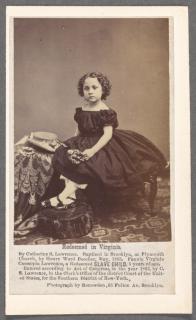
Visualizing Black Agency in Cartes de Visite Audio Guide
Popular in the 19th century, cartes de visite (CDV) are small type of studio photograph of about 2.5 by 4 inches, mounted onto card stock, and reproduced multiple times from negatives on thin paper upon request.
This exhibition presents Cartes de Visite with Black people in 19th century America as a strategic move to counter negative and distorted portrayals of Blacks in the visual narrative of the dominant society.
The postures, gazes, and facial expressions in these Cartes de Visite oppose the stereotypical representation of Blacks as lazy, ignorant, uncivilized, cowards, comical, and obedient servants dressed in rags. Each Carte de Visite in this exhibition communicates Black achievement, determination, and aspiration. Body posture, gaze, facial expression, and attire of each individual demonstrate agency, class, and respectability. Blacks reclaimed their identity, opposed their dehumanization, objectification, and stereotypical representation in the collective minds of the dominant American society.
They are evidence of Blacks' fight against negative representation and for freedom.
Short biographies accompany each Carte de Visite, along with links to the holding division, digital collection, and further readings. To access more Cartes de Visite, visit the Schomburg Center for Research in Black Culture, Photographs and Prints Division.



















